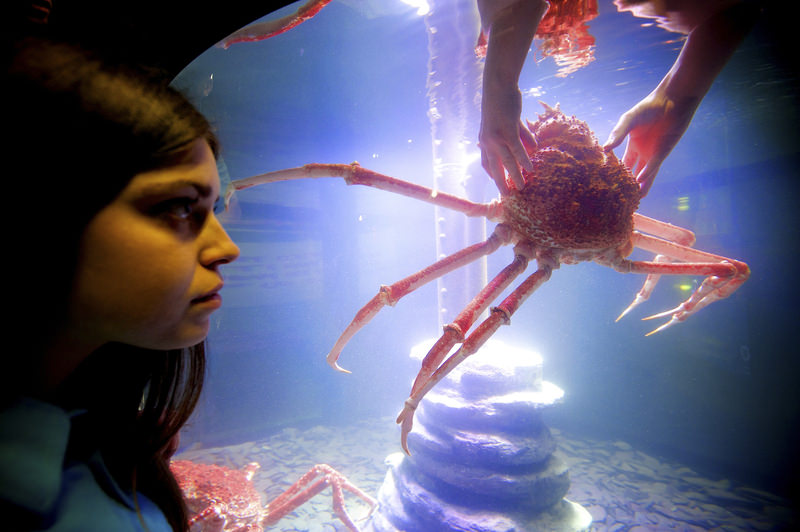

"A review of the Maja squinado (Crustacea : Decapoda : Brachyura) species-complex with a key to the eastern Atlantic and Mediterranean species of the genus". Official Journal of the European Communities. Journal of the Marine Biological Association of the United Kingdom. "Reproductive biology of spider crab females ( Maja brachydactyla) off the coast of Asturias (north-west Spain)". "Aggregating behaviour of the spider crab Maja squinado in shallow waters". thesis, Université de Bretagne Occidentale. "Biology and fisheries of the spider crab Maja squinado (Herbst) in western English Channel" (PDF) (in French). "Migratory patterns of female spider crabs Maja squinado detected using electronic tags and telemetry". " Maja squinado, the European Spider Crab: Biology and Fishery". squinado, and some individual countries have other regulations, such as a ban on landing egg-bearing females in Spain and a closed season in France and the Channel Islands. The European Union imposes a minimum landing size of 120 mm for M. squinado is the subject of commercial fishery, with over 5,000 tonnes caught annually, more than 70% the coast of France, over 10% off the coast of the United Kingdom, 6% from the Channel Islands, 3% from each of Spain and Ireland, 2% from Croatia, 1% from Portugal, and the remainder coming from Montenegro, Denmark, and Morocco, although official production figures are open to doubt. From a 1992 study done in Galicia, seaweeds from the Laminariaceae, Corallina spp., molluscs, the gastropods Bittium spp., Trochiidae, the bivalve Mytilus spp., echinoderms, and others were observed as part of the diet of this particular species. squinado has been documented to feed on macroalgae and benthic invertebrates.

Females can produce up to four broods per year. squinado becomes gregarious around that time, presumably for defense against predators. All crabs are vulnerable to predation when moulting, and M. Migrations generally take place in autumn, with some crabs covering over 100 mi (160 km) in 8 months. 27%) in the pubescent moult than in the prepubertal (approx. This also explains why there is a smaller increase in length (approx. Typically, the carapace length in animals that are already comparatively large increases less after moulting, relative to the initial size, than that of smaller animals. The average time interval between the two critical moults is 104 days. Likewise, three moults have been observed on some individual specimens. However, in captive animals it has been noticed that in very large individuals that are in the phase before one of the two moults, one moult may be lost entirely, or be very late. There are two main periods for the critical moults that follow the approximately two-year period of growth leading to sexual maturity: the first, the prepubertal, in April, and the second, the pubertal, from July to October. During this time they are not yet sexually mature. After this time, they reach a carapace length between 6–13 cm, with no noticeable sex-specific differences. They spend the summer on small rocky reefs at a depth of only about 4 m. The juvenile animals live in shallow water in winter, between rocks in coastal kelp forests. Juvenile animals spend another 2 years moulting and growing in size. The second moult marks the beginning of the third juvenile stage, the animal now has the appearance of the adult, with a carapace length of approx. Here there is a considerable increase in the length of the carapace to approx. squinado Near the beginning of the last growing phase, camouflaged in sea flora. Animals in the first juvenile stage perform their first moult about 21 days after hatching, and therefore enter the second juvenile stage. The same conditions in terms of food, temperature and the like cannot be created in a laboratory. 10.5% of the hatched zoea made it to this stage.

In observations under laboratory conditions, approx. From this stage only growth and the formation of sexual maturity follows. Its appearance is also similar to that of the adult animal. The larva then undergoes metamorphosis to the first juvenile instar, and changes its planktonic life to a benthic one (living on the sea floor). In a second phase, the Carapace grows to a length of approx. Within 4–8 days, the larva moults numerous times, finally ending with morphological changes that presumably include the further development and increase in size of the cephalothorax. squinado are slightly longer than 1mm after hatching, and weigh approximately 0.12 mg at this time.


 0 kommentar(er)
0 kommentar(er)
